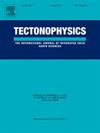Hydration weakening and destruction of the North China Craton
IF 2.7
3区 地球科学
Q2 GEOCHEMISTRY & GEOPHYSICS
引用次数: 0
Abstract
Cratons are generally considered the most stable parts of the lithosphere. However, recent studies have shown that some cratons have undergone significant thinning and even destruction. The destruction of the eastern part of the North China Craton has been documented through numerous geological, geochemical, and geophysical investigations. Yet, the exact mechanism behind this extensive thinning remains a subject of debate. In this study, we develop two dimensional (2-D) box models in a finite difference code LaMEM to identify the most viable reasons for the destruction of the North China Craton (NCC). We examine the role of slab-induced hydration, high-density lower crust, and weak mid-lithospheric discontinuity in our models. Results indicate that a low angle or flat slab-induced hydration weakening of the eastern part of the NCC can lead to rapid craton destruction if hydration weakening rates are sufficiently fast. This accelerated hydration rate may be attributed to the extensive carbonatite magmatism within the eastern part of the NCC, facilitating a faster pathway for water diffusion throughout the craton. Rapid craton destruction is also contingent upon the craton's density exceeding the surrounding mantle density, and its viscosity decreasing below Pa s. We observe that the presence of a dense lower crust or a mid-lithospheric discontinuity fail to destroy the NCC unless the craton is sufficiently weakened.
华北克拉通水化弱化与破坏
克拉通通常被认为是岩石圈中最稳定的部分。然而,最近的研究表明,一些克拉通经历了显著的变薄甚至破坏。华北克拉通东部的破坏已经通过大量的地质、地球化学和地球物理调查被记录下来。然而,这种大面积变薄背后的确切机制仍然是一个有争议的话题。在这项研究中,我们建立了有限差分代码LaMEM的二维(2-D)盒子模型,以确定华北克拉通(NCC)破坏的最可行原因。在我们的模型中,我们研究了板块引起的水化作用、高密度的下地壳和弱的中岩石圈不连续。结果表明,如果水化弱化速率足够快,北克拉通东部的低角度或平板水化弱化会导致克拉通的快速破坏。这种加速的水化速率可能与北克拉通东部广泛的碳酸盐岩岩浆活动有关,为水在克拉通中的扩散提供了更快的途径。克拉通的快速破坏还取决于克拉通的密度超过周围的地幔密度,并且其粘度降至1022 Pa以下。我们观察到,除非克拉通被充分削弱,否则致密的下地壳或中岩石圈不连续的存在不会破坏北克拉通。
本文章由计算机程序翻译,如有差异,请以英文原文为准。
求助全文
约1分钟内获得全文
求助全文
来源期刊

Tectonophysics
地学-地球化学与地球物理
CiteScore
4.90
自引率
6.90%
发文量
300
审稿时长
6 months
期刊介绍:
The prime focus of Tectonophysics will be high-impact original research and reviews in the fields of kinematics, structure, composition, and dynamics of the solid arth at all scales. Tectonophysics particularly encourages submission of papers based on the integration of a multitude of geophysical, geological, geochemical, geodynamic, and geotectonic methods
 求助内容:
求助内容: 应助结果提醒方式:
应助结果提醒方式:


